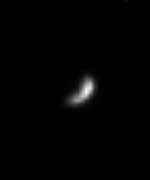The sharpest image ever taken of a dust disk around another star has revealed structures in the disk which are signs of unseen planets.
Dr. Michael Liu, an astronomer at the University of Hawaii’s Institute for Astronomy, has acquired high resolution images of the nearby star AU Microscopii (AU Mic) using the Keck Telescope, the world’s largest infrared telescope. At a distance of only 33 light years, AU Mic is the nearest star possessing a visible disk of dust. Such disks are believed to be the birthplaces of planets.
“We cannot yet directly image young planets around AU Mic, but they cannot completely hide from us either. They reveal themselves through their gravitational influence, forming patterns in the sea of dust grains orbiting the star,” said Dr. Liu.
The results will be published in the August 12th online Science Express and in the September print edition of Science.
A dust disk ordinarily would appear relatively featureless and symmetric, because any disturbances would be smoothed out as the material orbits the star. However, this is not observed in the case of AU Mic. Instead, Dr. Liu has found its disk is uneven and possesses clumps. These structures arise and are maintained due to the gravitational influence of unseen planetary companions.
The clumps in AU Mic’s disk lie at separations of 25 to 40 Astronomical Units away from the central star (where one Astronomical Unit is the distance from the Earth to the Sun), or about 2 to 4 billion miles. In our own solar system, this corresponds to the regions where Neptune and Pluto reside.
AU Mic is a dim red star, with only half the mass and one-tenth the energy output as the Sun. Previous studies have shown that AU Mic is about 12 million years old, an epoch believed to be an active phase of planet formation. In comparison, our Sun is about 4.6 billion years old, or about 400 times older, and planet formation has long since ended.
“By studying very young stars like AU Mic, we gain insight into the planet formation process as it is occurring. As a result, we learn about the birth of our own solar system and its planets,” said Liu.
The images alone cannot yet tell us what kinds of planets are present, only that the planets are massive enough to gravitationally alter the distribution of the dust. However, many structures in the AU Mic disk are observed to be elliptical (non-circular), indicating that the planetary orbits are elliptical. This is different than in our own solar system, where most planets follow circular orbits.
Images of disks around nearby stars are very rare. Earlier this year, Dr. Liu and his colleagues announced the discovery of the large dusty disk around AU Mic. The light from AU Mic’s disk arises from small dust particles which reflect the light of the central star. The new images are 30 times sharper than the earlier ones, enabling discovery of the clumps in the inner disk of AU Mic.
Dr. Liu used the Keck II Telescope located on Mauna Kea, Hawaii for this research. The two Keck Telescopes are the largest infrared telescopes in the world, each with a primary mirror of 10-meter (33 feet) in diameter. The telescopes are equipped with adaptive optics, a powerful technology which corrects astronomical images for the blurring caused by the Earth’s turbulent atmosphere.
The resulting infrared images are the sharpest ever obtained of a circumstellar disk, with an angular resolution of 1/25 of an arcsecond, about 1/500,000 the diameter of the full moon. If a person’s vision were as sharp as the Keck adaptive optics system, he would be able to read a magazine that was one mile away. In the case of AU Mic, the Keck images can see features as small as 0.4 Astronomical Units, less than half the distance from the Earth to the Sun.
“It is remarkable how quickly Adaptive Optics at Keck has come from being an exotic demonstration technology to producing scientific results of unprecedented quality,” said Dr. Frederic H. Chaffee, the director of the W. M. Keck Observatory. “We are entering a new age of high resolution imaging in astronomy. Dr. Liu’s breathtaking images of possible planets in formation around AU Mic would have been unimaginable from any telescope — space-based or on Earth — a few short years ago. This is an exciting time for us all.”
A preprint of the paper may be found at the astro-ph website
http://arxiv.org/abs/astro-ph/0408164
This work was supported in part by the National Science Foundation.
Original Source: IfA News Release

